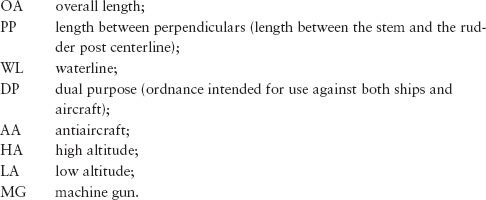
This appendix details the specifications and histories of the naval aviation vessels in the Japanese inventory at the outbreak of the Pacific War. In all cases, the vessels are depicted as they would have appeared in December 1941.
The hangar-deck dimensions of many of these vessels are known only approximately. Even “exact” dimensions can be misleading, as the spaces themselves were invariably irregular in shape. Thus, the square-footage figure provided should be used as a rough measure of the aircraft-carrying capacity of the vessel rather than as a hard-and-fast figure.
The following abbreviations are used in this appendix:
OA |
overall length; |
PP |
length between perpendiculars (length between the stem and the rudder post centerline); |
WL |
waterline; |
DP |
dual purpose (ordnance intended for use against both ships and aircraft); |
AA |
antiaircraft; |
HA |
high altitude; |
LA |
low altitude; |
MG |
machine gun. |

Fig. A4-1. Aircraft carrier Hōshō
The following plans and photographic sources were used in compiling this appendix: SZ, 1; Jentschura et al., Warships of the Imperial Japanese Navy; Chesneau, Aircraft Carriers of the World; Hasegawa, Nihon no kōkūbōkan; Katō Sadatoshi, Nihon kaigun kantei zumen, no. 3; D. Brown, Aircraft Carriers; Nakamura, Taiheiyō sensō shi shirizu, nos. 13 and 14; Maru Magazine, Nihon kaigun kantei shashinshū, nos. 5 and 6; Watts and Gordon, Imperial Japanese Navy; and additional miscellaneous plans in the possession of the illustrator.
Hōshō
Builder: |
Asano Shipbuilding Co., Tsurumi |
Laid down: |
16 Dec 1919 |
Launched: |
13 Nov 1921 |
Commissioned: |
27 Dec 1922 |
Displacement: |
7,470 tons (standard), 9,630 tons (normal) |
Length: |
551ft 6in (OA), 541ft 4in (WL), 510ft 0in (PP) |
Beam: |
59ft 1in |
Draught: |
20ft 3in |
Machinery: |
2 sets Parsons geared turbines, 12 Kampon boilers, 2 shafts |
Performance: |
30,000shp; 25 knots |
Bunkerage: |
2,695 tons fuel, 940 tons coal |
Range: |
8,000nm at 14 knots |
Flight-deck dimensions: |
519ft 0in × 74ft 6in |
Elevators: |
2 (42ft 4in × 27ft 10in, 44ft 11in × 36ft 1in) |
Arrester wires: |
6 |
Hangar decks: |
1 |
Hangar dimensions: |
423ft 6in × 55ft 0in (max); 23,292sq ft (approx) |
Aircraft: |
11 |
Armament: |
16 × 25mm AA |
Armor: |
None |
Complement: |
550 |
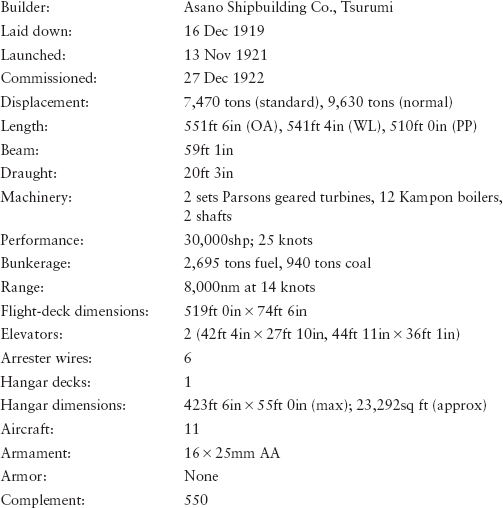
NOTES: Originally laid down as an oiler. Work was suspended on the Hōshō’s hull when Japan decided to complete her instead as the navy’s first aircraft carrier. As such, her hull form was little changed from the original design, a single hangar being added on top of the old weather deck. Originally a simple island was fitted on the starboard side, but this was removed shortly after her trials owing to the hazards it created for landing aircraft on the small flight deck.
The Hōshō’s flight deck provided much of the early experimentation in Japanese naval aviation in the 1920s. Among other things, she was a test bed for both arresting-gear systems and optical landing aids (lights). By the outbreak of the Pacific War, the Hōshō was clearly a second-rate unit and consequently spent most of her time as a training ship. She did, however, participate in the Midway campaign by providing fighter cover for the Main Body. Although attacked by U.S. carrier aircraft at Kure in 1945, the Hōshō survived the war and was used as a repatriation ship. She was scrapped in 1947.
Fig. A4-2. Aircraft carrier Akagi
Builder: |
Kure Naval Dockyard |
Laid down: |
6 Dec 1920 |
Launched: |
22 Apr 1925 |
Commissioned: |
25 Mar 1927 |
As Built
Displacement: |
26,900 tons (standard), 34,364 tons (normal) |
Length: |
857ft 0in (OA), 816ft 7in (WL), 764ft 5in (PP) |
Beam: |
95ft 0in |
Draught: |
26ft 6in |
Machinery: |
Gijitsu Honbu geared turbines, 19 Kampon boilers, 4 shafts |
Performance: |
131,000shp; 31 knots |
Bunkerage: |
3,900 tons fuel oil, 2,100 tons coal |
Range: |
8,000nm at 14 knots |
Flight-deck dimensions: |
562ft 0in × 100ft 0in, plus 60ft (approx) and 160ft (approx) flying-off platforms at hangar-deck levels |
Elevators: |
2 (38ft 6in × 42ft 8in, 42ft 0in × 27ft 6in) |
Arrester wires: |
Longitudinal system initially, then 6 wires (electrically controlled) |
Hangar decks: |
3 (upper, middle, and lower; lower used for disassembled aircraft stowage only) |
Hangar dimensions: |
upper 516ft × 75ft (approx), middle 557ft × 75ft (approx), lower 170ft × 50ft (approx); upper and middle hangar area 80,475sq ft total (approx), lower hangar 8,515sq ft (approx) |
Aircraft: |
60 |
Armament: |
10 × 8in/50-cal LA, 12 × 4.7in/45-cal HA, 22 MGs |
Armor: |
6in belt, 3.1in deck |
Complement: |
1,600 |
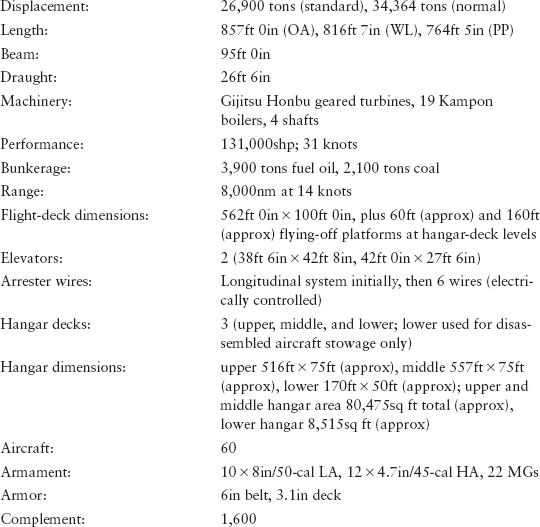
Displacement: |
36,500 tons (standard), 41,300 tons (normal) |
Length: |
855ft 3in (OA), 821ft 5in (WL), 770ft 0in (PP) |
Beam: |
102ft 9in |
Draught: |
28ft 7in |
Machinery: |
Gijitsu Honbu geared turbines, 19 Kampon boilers, 4 shafts |
Performance: |
133,000shp; 31.25 knots |
Bunkerage: |
5,775 tons fuel oil |
Range: |
8,200nm at 16 knots |
Flight-deck dimensions: |
817ft 6in × 100ft 0in |
Elevators: |
3 (38ft 6in × 42ft 6in, 42ft 0in × 27ft 6in, 37ft 6in × 41ft 3in) |
Arrester wires: |
9 (hydraulic) |
Hangar decks: |
3 (upper, middle, and lower; lower used for disassembled aircraft stowage only) |
Hangar dimensions: |
upper and middle 620ft × 75ft (approx), lower 170ft × 50ft (approx); upper and middle hangar area 93,000sq ft (approx), lower hangar 8,515sq ft (approx) |
Aircraft: |
91 |
Armament: |
6 × 8in/50-cal LA, 12 × 4.7in/45-cal HA, 28 × 25mm AA |
Armor: |
6in belt, 3.1in deck |
Complement: |
2,000 |
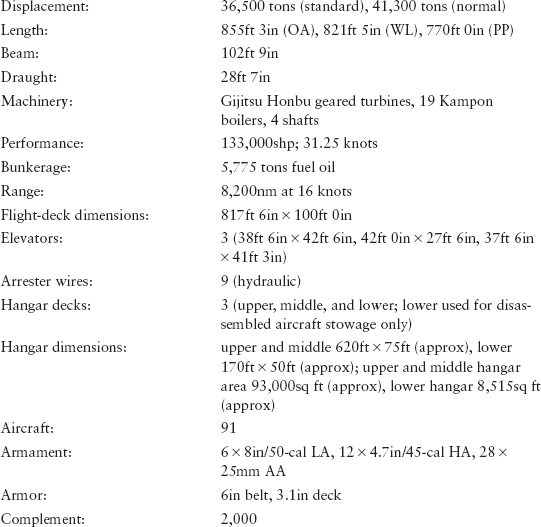
NOTES: The Akagi was originally laid down as a battle cruiser in 1920. Subsequent to the Washington Naval Treaty of 1922, she was taken in hand in late 1923 for completion as an aircraft carrier. After significant alterations—including major revisions to the armor belt to conserve top weight for usage in the aircraft hangars—the Akagi was launched in 1925 and commissioned two years later.
As constructed, the Akagi had three aircraft flight decks and no superstructure. The validity of this arrangement was called into question as aircraft and flight-deck operational techniques evolved in the 1930s. After a major refit beginning in October 1935, she emerged in August 1938 with a single full-length flight deck, enlarged hangar space, a third lift, and a true carrier “island” carried on the port side of the flight deck. Antiaircraft armament was also increased.
As Japan’s first true fleet carrier, the Akagi (along with the Kaga,) acted as a test bed for the development of Japanese naval air doctrine throughout the 1930s. She served as flagship of Carrier Division 1 and as flagship of the First Air Fleet from April 1940 onward. She participated in actions against China and in every major carrier campaign during the opening stages of the Pacific War. She was scuttled on 5 June 1942 during the Battle of Midway, after receiving two bomb hits that resulted in uncontrollable fires and induced explosions.
Kaga
Builder: |
Kawasaki Dockyard Co. and Yokosuka Naval Dockyard |
Laid down: |
19 Jul 1920 |
Launched: |
17 Nov 1921 |
Commissioned: |
31 Mar 1928 |

As Built
Displacement: |
26,000 tons (standard), 33,693 tons (normal) |
Length: |
782ft 6in (OA), 771ft 0in (WL), 715ft 1in (PP) |
Beam: |
97ft 0in |
Draught: |
26ft 0in |
Machinery: |
Brown-Curtiss geared turbines, 12 Kampon boilers, 4 shafts |
Performance: |
91,000shp; 28.5 knots |
Bunkerage: |
3,600 tons fuel oil, 1,700 tons coal |
Range: |
8,000nm at 14 knots |
Flight-deck dimensions: |
560ft 0in × 100ft 0in, plus 60ft (approx) and 160ft (approx) flying-off platforms at hangar-deck levels |
Elevators: |
2 (37ft 8in × 39ft 5in, 35ft 0in × 52ft 0in) |
Arrester wires: |
6 (electrically controlled) |
Hangar decks: |
3 (upper, middle, and lower; lower used for disassembled aircraft stowage only) |
Hangar dimensions: |
upper 415ft × 65ft (approx), middle 470ft × 75ft (approx), lower 116ft × 48ft (approx); upper and middle hangar area 62,225sq ft (approx), lower hangar 5,568sq ft (approx) |
Aircraft: |
60 |
Armament: |
10 × 8in/50-cal LA, 12 × 4.7in/45-cal HA, 2 MGs |
Armor: |
6in belt, 1.5in deck |
Complement: |
1,340 |
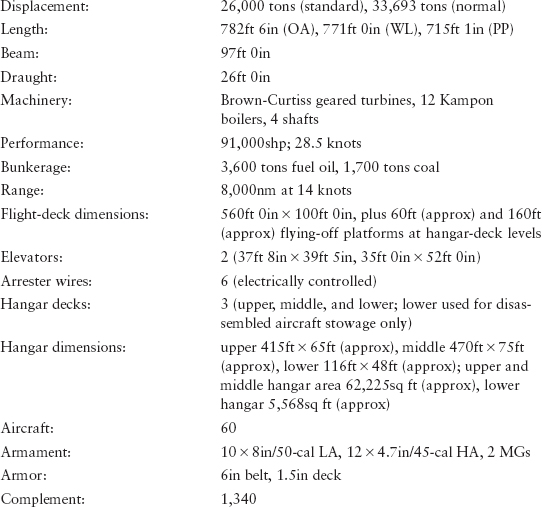
As Reconstructed (1934–35)
Displacement: |
38,200 tons (standard), 42,541 tons (normal) |
Length: |
812ft 6in (OA), 788ft 5in (WL), 738ft 2in (PP) |
Fig. A4-3. Aircraft carrier Kaga
106ft 8in |
|
Draught: |
31ft 1in |
Machinery: |
Kampon geared turbines, 8 Kampon boilers, 4 shafts |
Performance: |
127,400shp; 28 knots |
Bunkerage: |
8,208 tons fuel oil, 600 tons avgas |
Range: |
10,000nm at 16 knots |
Flight-deck dimensions: |
815ft 6in × 100ft 0in |
Elevators: |
3 (37ft 8in × 39ft 5in, 35ft 0in × 52ft 0in, 42ft 0in × 31ft 5in) |
Arrester wires: |
9 (hydraulically controlled) |
Hangar decks: |
3 (upper, middle, and lower; lower used for disassembled aircraft stowage only) |
Hangar dimensions: |
upper and middle 615ft × 88ft (approx), lower 116ft × 48ft (approx); upper and middle hangar area 108,240sq ft (approx), lower hangar 5,568sq ft (approx) |
Aircraft: |
91 |
Armament: |
10 × 8in/50-cal LA, 16 × 5in/40-cal DP, 22 × 25mm AA |
Armor: |
6in belt, 1.5in deck |
Complement: |
2,016 |

NOTES: Because of the limitations on capital ship construction imposed by the Washington Naval Treaty, work on the battleship Kaga was halted in 1922. Following the destruction of the then-building Amagi in the Tokyo earthquake of 1923, the Kaga was selected to replace her for completion as an aircraft carrier. Alterations included revisions to armor layout to conserve top weight. She was launched in 1925 and commissioned three years later after an extensive fitting-out period. Like the Akagi, the Kaga had three aircraft flight decks and no superstructure as built. After only six years in service she underwent a major refit beginning in June 1934. Her hull was lengthened, a single full-length flight deck erected, hangar spaces enlarged, a third lift added, and an island built on the starboard side of the flight deck. Her heavy antiaircraft armament was upgraded, and light AA was also increased.
The Kaga participated in actions against China and in every major carrier campaign during the opening stages of the Pacific War. She was sunk on 4 June 1942 during the Battle of Midway, as the result of four bomb hits producing fires and induced explosions.
Fig. A4-4. Aircraft carrier Ryūjō
Builder: |
Yokohama Dockyard Co. |
Laid down: |
26 Nov 1929 |
Launched: |
2 Apr 1931 |
Commissioned: |
9 May 1933 |
As Built
Displacement: |
12,500 tons (standard) |
Length: |
590ft 3in (OA), 575ft 5in (WL), 548ft 7in (PP) |
Beam: |
66ft 8in |
Draught: |
18ft 3in |
Machinery: |
2 sets geared turbines, 6 Kampon boilers, 2 shafts |
Performance: |
65,000shp; 29 knots |
Bunkerage: |
2,490 tons fuel oil |
Range: |
10,000nm at 14 knots |
Flight-deck dimensions: |
513ft 6in × 75ft 6in |
Elevators: |
2 (51ft 6in × 36ft 5in, 35ft 5in × 26ft 3in) |
Arrester wires: |
6 |
Hangar decks: |
2 |
Hangar dimensions: |
both 336ft 0in × 62ft 2in (approx); 41,664sq ft (approx) |
Aircraft: |
48 |
Armament: |
12 × 5in/40-cal DP, 24 MGs |
Armor: |
None |
Complement: |
600 |
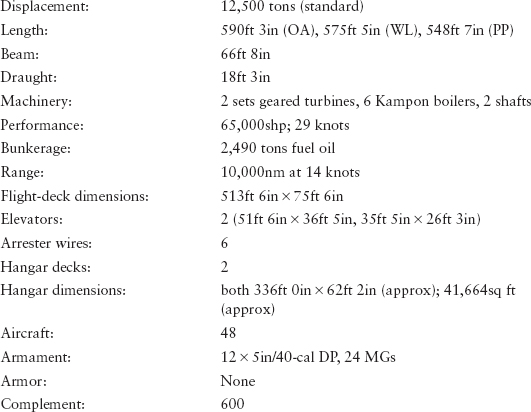
As Reconstructed (1934–36)
Displacement: |
10,600 tons (standard), 12,732 tons (normal) |
Length: |
590ft 3in (OA), 576ft 6in (WL), 550ft 4in (PP) |
Beam: |
68ft 2in |
Draught: |
23ft 3in |
Machinery: |
2 sets geared turbines, 6 Kampon boilers, 2 shafts |
Performance: |
66,269shp; 29 knots |
Bunkerage: |
2,490 tons fuel oil |
Range: |
10,000nm at 14 knots |
Flight-deck dimensions: |
513ft 6in × 75ft 6in |
Elevators: |
2 (51ft 6in × 36ft 5in, 35ft 5in × 26ft 3in) |
Arrester wires: |
6 |
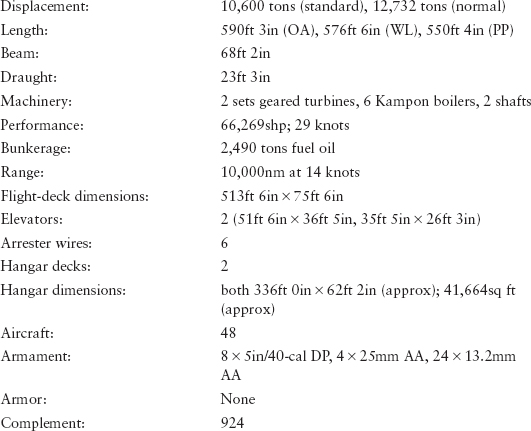
Fig. A4-5. Aircraft carrier Sōryū
2 |
|
Hangar dimensions: |
both 336ft 0in × 62ft 2in (approx); 41,664sq ft (approx) |
Aircraft: |
48 |
Armament: |
8 × 5in/40-cal DP, 4 × 25mm AA, 24 × 13.2mm AA |
Armor: |
None |
Complement: |
924 |
NOTES: Owing to the aggregate tonnage dedicated to the Akagi and Kaga (nearly 53,000 tons), under the limitations of the Washington Naval Treaty Japan was left with only 30,000 tons of allowable carrier construction. The Japanese were determined to spread this remaining tonnage across as many hulls as possible while still ensuring that each carrier was capable of operating a useful air wing. The result of these irreconcilable design pressures was the Ryūjō, a carrier that was supposed to embark forty-eight aircraft, displace only 8,000 tons, and maintain battle speed with the fleet. Not surprisingly, the Ryūjō was a failed compromise in a number of respects. Her original aircraft complement having been deemed insufficient after her ordering, a second aircraft hangar was almost arbitrarily placed on top of her original single-hangar design. As built, she was lightly constructed, lacking in longitudinal girder strength and freeboard, and dangerously top-heavy. The Ryūjō was badly damaged while on maneuvers in the monster typhoon of 1934, where her structural liabilities were brought into glaring focus. She went back to the yards after a little more than a year in service.
When the Ryūjō reemerged, her hull had been strengthened, ballasted, and widened. This modification, in combination with the removal of a pair of her 5-inch DP mounts, greatly improved the Ryūjō’s stability, but her marginal freeboard had been lowered still further. Subsequent work to heighten her forecastle improved this condition somewhat. However, by 1940 the improvement (and enlargement) of combat aircraft had made it impossible for her smaller aft elevator to stow any combat aircraft (except possibly the B5N, which had folding wings), meaning that she was essentially a single-lift carrier. Furthermore, the diminutive size of her flight deck made it impossible for her to operate more than a half-dozen nonfighter aircraft in a single strike package. In all, the Ryūjō was of distinctly marginal utility as a light fleet carrier.
The Ryūjō saw extensive service in the opening phases of the Pacific War, mostly in support of Japanese amphibious operations. She was sunk on 24 August 1942 during the Battle of the Eastern Solomons, the victim of four bombs and a torpedo hit that left her a blazing wreck.
Sōryū
Builder: |
Kure Naval Dockyard |
Laid down: |
20 Nov 1934 |
Launched: |
21 Dec 1935 |
Fig. A4-6. Aircraft carrier Hiryū
29 Jan 1937 |
|
Displacement: |
15,900 tons (standard), 18,800 tons (normal) |
Length: |
746ft 5in (OA), 729ft 9in (WL), 677ft 7in (PP) |
Beam: |
69ft 11in |
Draught: |
25ft 0in |
Machinery: |
4 sets geared turbines, 8 Kampon boilers, 4 shafts |
Performance: |
152,000shp; 34.5 knots |
Bunkerage: |
3,670 tons fuel oil, 150,000 gallons avgas |
Range: |
7,750nm at 18 knots |
Flight-deck dimensions: |
711ft 6in × 85ft 4in |
Elevators: |
3 (37ft 9in × 52ft 6in, 37ft 9in × 39ft 4in, 38ft 8in × 32ft 10in) |
Arrester wires: |
9 (hydraulically controlled) |
Hangar decks: |
2 |
Hangar dimensions: |
upper 562ft × 60ft × 15ft (approx), lower 467ft × 60ft × 14ft (approx); 61,740sq ft (approx) |
Aircraft: |
68 |
Armament: |
12 × 5in/40-cal DP, 28 × 25mm AA |
Armor: |
1.8in belt, 1in deck (2.2in over the magazines) |
Complement: |
1,100 |
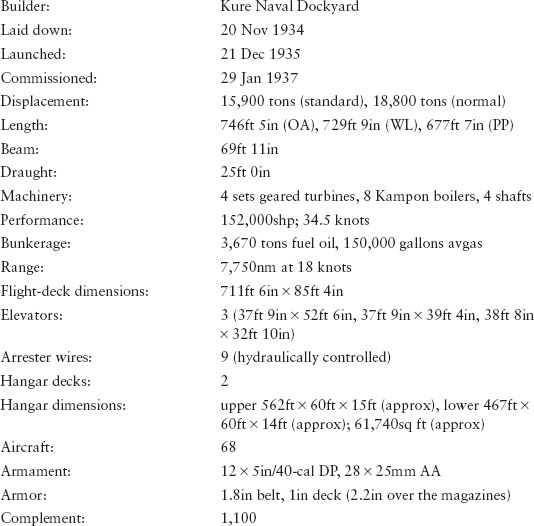
NOTES: The Sōryū, the first of Japan’s third-generation carriers, established the basic format for all future Japanese carrier classes: a high-aspect cruiserlike hull mounting powerful machinery for high speed, twin downswept stacks to vent exhaust gases away from the flight deck, dual hangar decks served by three lifts, light construction, and little or no armor protection. As such, she approached the ideal carrier (at least according to Japanese naval doctrine): long on speed, range, and offensive capabilities, but lacking in defensive staying power.
The Sōryū served alongside her larger sister Hiryū in Carrier Division 2 for most of her career. The Sōryū was involved in actions in China and in every major carrier campaign during the opening stages of the Pacific War. She was the first of the four Japanese carriers sunk during the Battle of Midway on 4 June 1942. Smashed by three bomb hits among her parked aircraft and in her hangars, she was soon ablaze from stem to stern, sinking some nine hours later.
Hiryū
Builder: |
Yokosuka Naval Dockyard |
Laid down: |
8 Jul 1936 |
Launched: |
16 Nov 1937 |
Commissioned: |
5 Jul 1939 |
Fig. A4-7. Aircraft carrier Zuihō
17,300 tons (standard), 20,250 (normal) |
|
Length: |
745ft 11in (OA), 721ft 9in (WL), 687ft 5in (PP) |
Beam: |
73ft 3in |
Draught: |
25ft 9in |
Machinery: |
4 sets geared turbines, 8 Kampon boilers, 4 shafts |
Performance: |
153,000shp; 34.5 knots |
Bunkerage: |
4,400 tons fuel oil (approx) |
Range: |
10,330nm at 18 knots |
Flight-deck dimensions: |
711ft 6in × 88ft 6in |
Elevators: |
3 (42ft 8in × 52ft 6in, 42ft 8in × 39ft 4in, 38ft 8in × 42ft 8in) |
Arrester wires: |
6 aft, 3 forward, all hydraulic |
Hangar decks: |
2 |
Hangar dimensions: |
upper 562ft × 60ft × 15ft (approx), lower 467ft × 60ft × 14ft (approx); 61,740sq ft (approx) |
Aircraft: |
73 |
Armament: |
12 × 5in/40-cal DP, 31 × 25mm AA |
Armor: |
3.5in belt (magazines 5.9in), 1in deck (2.2in over the magazines) |
Complement: |
1,100 |
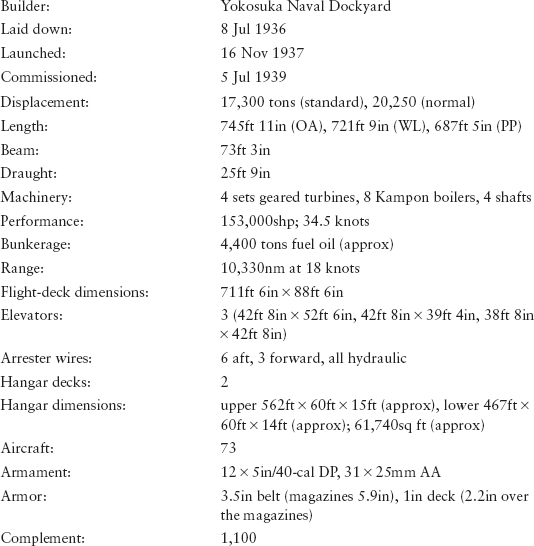
NOTES: The Hiryū, a slightly enlarged version of the Sōryū, improved on her smaller sister in a number of respects, notably combat range—owing to a 20 percent increase in her fuel capacity—and protection, although by contemporary foreign standards her defensive arrangements were still woefully inadequate. Nevertheless, with her long range, high speed, and relatively large airwing, she was judged by the Japanese to be a highly useful design that was to be reincarnated in the late-war Unryū-class ships.
The Hiryū was involved in operations against China and was heavily used during the opening phases of the Pacific War. She was the last of four Japanese carriers sunk at the Battle of Midway, receiving four bomb hits on her forward flight deck that started insurmountable fires.
Shōhō AND Zuihō
Shōhō
Builder: |
Yokosuka Naval Dockyard |
Laid down: |
3 Dec 1934 |
Launched: |
1 Jun 1935 |
Commissioned: |
26 Jan 1942 |
Builder: |
Yokosuka Naval Dockyard |
Laid down: |
20 Jun 1935 |
Launched: |
19 Jun 1936 |
Commissioned: |
27 Dec 1940 |
Displacement: |
11,262 tons (standard), 13,950 tons (normal) |
Length: |
674ft 2in (OA), 660ft 11in (WL), 606ft 11in (PP) |
Beam: |
59ft 8in |
Draught: |
21ft 7in |
Machinery: |
2 sets geared turbines, 4 boilers, 2 shafts |
Performance: |
52,000shp; 28 knots |
Bunkerage: |
2,600 tons fuel oil (approx) |
Range: |
7,800nm at 18 knots |
Flight-deck dimensions: |
590ft 6in × 75ft 6in |
Elevators: |
2 (42ft 8in × 39ft 4in, 39ft 4in × 35ft 5in) |
Arrester wires: |
6 |
Hangar decks: |
1 |
Hangar dimensions: |
406ft 10in × 59ft 0in; 24,013sq ft (approx) |
Aircraft: |
30 |
Armament: |
8 × 5in/40-cal DP, 8 × 25mm AA |
Armor: |
None |
Complement: |
785 |
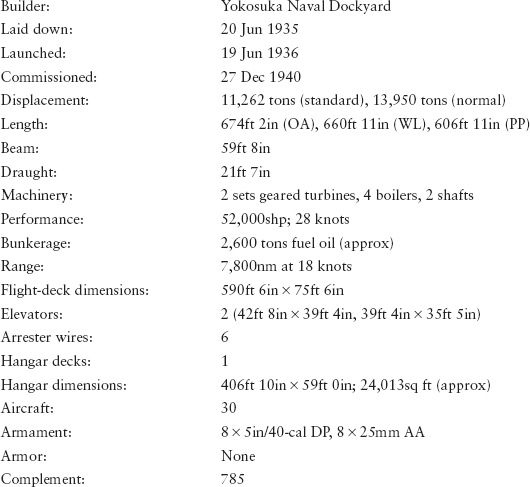
NOTES: These ships were originally laid down as submarine tenders (the Tsurugisaki and Takasaki respectively) but were ostensibly intended for conversion to either fleet oilers or light carriers as needed. Yet as it happened, the Zuihō’s conversion to a carrier took some four years. Both the Zuihō and Shōhō were useful light carriers as they finally emerged, but their insufficient aircraft complement prevented them from operating independently. Strictly speaking, the Shōhō was not in commission at the beginning of the Pacific War. However, she had previously been in commission as a submarine tender and was only a little more than a month away from being recommissioned as an aircraft carrier when the war began.
The Shōhō was lost during her first combat deployment, during the Battle of the Coral Sea on 7 May 1942. She was struck by no fewer than eleven aerial bomb and seven torpedo hits, and sank within minutes. The Zuihō participated in several campaigns, finally being lost during the Battle of Cape Engano on 25 October 1944, a victim of multiple bomb and torpedo hits.
Shōkaku
Builder: |
Yokosuka Naval Dockyard |
Laid down: |
12 Dec 1937 |
Launched: |
1 Jun 1939 |
Commissioned: |
8 Aug 1941 |
Zuikaku
Builder: |
Kawasaki Dockyard, Kobe |
Laid down: |
25 May 1938 |
Launched: |
27 Nov 1939 |
Commissioned: |
25 Sep 1941 |
Displacement: |
25,675 tons (standard), 29,800 tons (normal) |
Length: |
844ft 10in (OA), 820ft 2in (WL), 774ft 6in (PP) |
Beam: |
85ft 4in |
Draught: |
29ft 1in |
Machinery: |
4 sets geared turbines, 8 Kampon boilers, 4 shafts |
Performance: |
160,000shp; 34.25 knots |
Bunkerage: |
3,500 tons fuel oil, 150 tons avgas |
Range: |
9,700nm at 18 knots |
Flight-deck dimensions: |
794ft 7in × 95ft 2in |
Elevators: |
3 (52ft 6in × 42ft 6in, 42ft 6in × 39ft 4in, 42ft 6in × 38ft 6in) |
Arrester wires: |
6 aft, 3 forward |
Hangar decks: |
2 |
Hangar dimensions: |
upper 623ft × 78ft (approx), lower 525ft × 78ft (approx); 87,675sq ft (approx) |
Aircraft: |
84 |
Armament: |
16 × 5in/40-cal DP, 42 × 25mm AA |
Armor: |
5.9–8.5in belt, 6.7in deck |
Complement: |
1,660 |
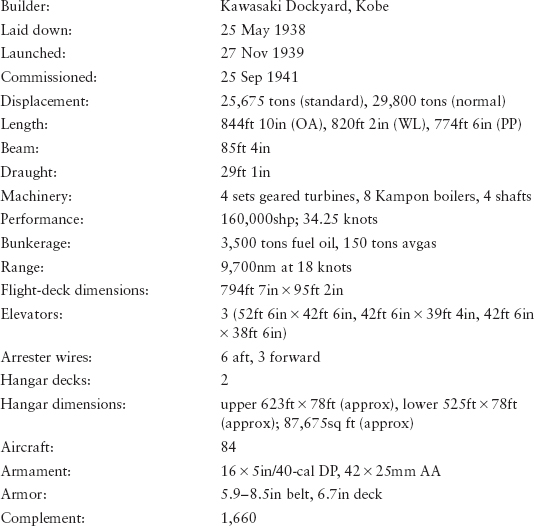
NOTES: With the possible exception of the later Taihō, the magnificent Shōkaku-class carriers were the finest expression of Japanese carrier design and were arguably the best aircraft carriers in the world until the emergence of the American Essex class in 1943. Combining all the virtues of the Sōryū with greatly increased protection and expanded aircraft-handling capacity, the Shōkakus had few drawbacks besides an unarmored flight deck. Their impending entry into the imperial fleet factored heavily into the Combined Fleet’s calculations for the feasibility of the Pearl Harbor attack.
Fig. A4-8. Aircraft carrier Shōkaku
The Shōkakus were the most active Japanese carriers during the Pacific War, participating in almost every major campaign except the Battle of Midway. The Shōkaku succumbed to damage from three or four submarine torpedo hits during the Battle of the Philippine Sea on 19 June 1944. The Zuikaku was sunk during the Battle of Cape Engano on 25 October 1944, having been hit by numerous aerial bombs and torpedoes.
Taiyō (formerly Kasuga Maru)
Builder: |
Mitsubishi, Nagasaki |
Laid down: |
6 Jan 1940 |
Launched: |
19 Sep 1940 |
Commissioned: |
15 Sep 1941 |
Displacement: |
17,830 tons (standard), 20,000 tons (normal) |
Length: |
591ft 4in (OA), 569ft 11in (WL), 551ft 2in (PP) |
Beam: |
73ft 10in |
Draught: |
26ft 3in |
Machinery: |
2 sets geared turbines, 4 boilers, 2 shafts |
Performance: |
25,200shp; 21.1 knots |
Bunkerage: |
? |
Range: |
6,500nm at 18 knots |
Flight-deck dimensions: |
564ft 3in × 77ft 0in |
Elevators: |
2 (39ft 5in × 42ft 8in, 42ft 8in × 39ft 5in) |
Arrester wires: |
8 |
Hangar decks: |
1 |
Hangar dimensions: |
300ft long (approx) |
Aircraft: |
27 |
Armament: |
6 × 4.7in HA, 8 × 25mm AA |
Armor: |
None |
Complement: |
747 |
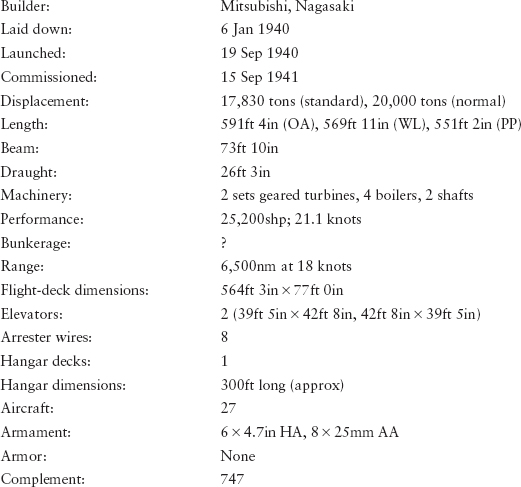
NOTES: The Taiyō was formerly a 17,100grt passenger liner taken in hand for quick conversion to an escort carrier at Sasebo Naval Yard in 1940. During her conversion a single hangar deck was added, her boilers were rerouted to vent over the side, and minimal antiaircraft armament and fire-control equipment were fitted. Interestingly, no arrester gear was installed, which undoubtedly complicated the handling of modern high-performance carrier aircraft.
Fig. A4-9. Aircraft carrier Taiyō
The Taiyō was used mainly for aircraft transport and training duties during the Pacific War. She was sunk by the U.S. submarine Rasher on 18 August 1944 off Luzon, the Philippines.

Fig. A4-10. Seaplane carrier Notoro
Notoro
Builder: |
Kawasaki, Kobe |
Laid down: |
24 Nov 1919 |
Launched: |
3 May 1920 |
Commissioned: |
10 Aug 1920 |
Displacement: |
14,050 tons (standard) |
Length: |
470ft 9in (OA), 455ft 0in (PP) |
Beam: |
58ft 0in |
Draught: |
26ft 6in |
Machinery: |
2 sets vertical triple-expansion reciprocating engines, 4 Miyabara boilers, 2 shafts |
Performance: |
5,850shp; 12 knots |
Bunkerage: |
1,000 tons fuel oil |
Range: |
? |
Aircraft: |
10–16 seaplanes |
Armament: |
2 × 4.7in LA, 2 × 80mm AA |
Armor: |
None |
Complement: |
155 |
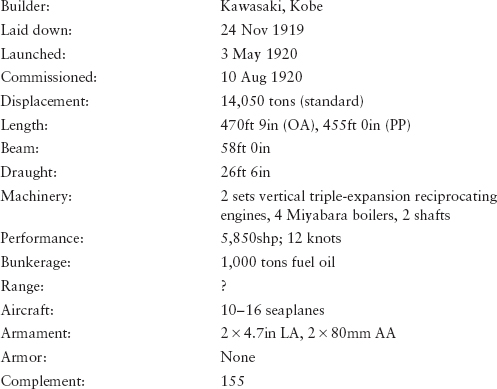
NOTES: Originally built as an oiler, the Notoro was converted to a seaplane carrier in 1924. However, she retained capabilities as an oiler and was reconverted to this purpose in 1942.
Fig. A4-11. Seaplane carrier Kamoi
Kamoi
Builder: |
New York Shipbuilding Co., Camden, N.J. |
Laid down: |
14 Sep 1921 |
Launched: |
8 Jun 1922 |
Commissioned: |
12 Sep 1922 |
Displacement: |
19,550 tons (normal), 17,000 (standard) |
Length: |
496ft 3in (OA), 496ft 0in (WL), 488ft 6in (PP) |
Beam: |
67ft 0in |
Draught: |
27ft 8in |
Machinery: |
2 sets Curtiss turbo-electric drive, 2 Yarrow boilers, 2 shafts |
Performance: |
9,000shp; 15 knots |
Bunkerage: |
2,500 tons coal |
Range: |
10,000nm at 10 knots |
Aircraft: |
12–16 seaplanes |
Armament: |
2 × 5.5in LA, 2 × 80mm AA |
Armor: |
None |
Complement: |
? |
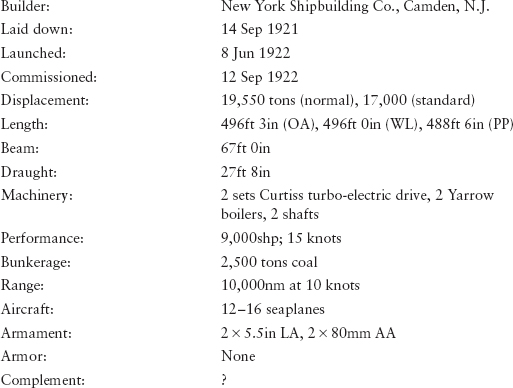
NOTES: Completed as a fleet oiler, the Kamoi was converted to a seaplane carrier by Uraga Dock Co., Tokyo, in 1933. She was reclassified as a fleet oiler in 1943.
Chitose
Builder: |
Kure Naval Dockyard |
Laid down: |
26 Nov 1934 |
Launched: |
29 Nov 1936 |
Commissioned: |
25 Jul 1938 |
Chiyoda
Builder: |
Kure Naval Dockyard |
Laid down: |
14 Dec 1936 |
Launched: |
19 Nov 1937 |
Commissioned: |
15 Dec 1938 |
Displacement: |
12,550 tons (normal), 11,023 (standard) |
Length: |
631ft 7in (OA), 603ft 4in (WL), 570ft 10in (PP) |
Beam: |
61ft 8in |
Draught: |
23ft 8in |
Machinery: |
2 sets geared turbines, 4 Kampon boilers, 2 diesel engines, 2 shafts |
Performance: |
44,000shp (+ diesels = 12,800bhp); 29 knots |
Bunkerage: |
3,600 tons fuel oil |
Range: |
8,000nm at 18 knots |
Catapults: |
4 |
Hangar decks: |
1 |
Hangar dimensions: |
300ft long (approx) |
Aircraft: |
24 seaplanes |
Armament: |
2 × 5in/40-cal DP, 12 × 25mm AA |
Armor: |
None |
Complement: |
? |
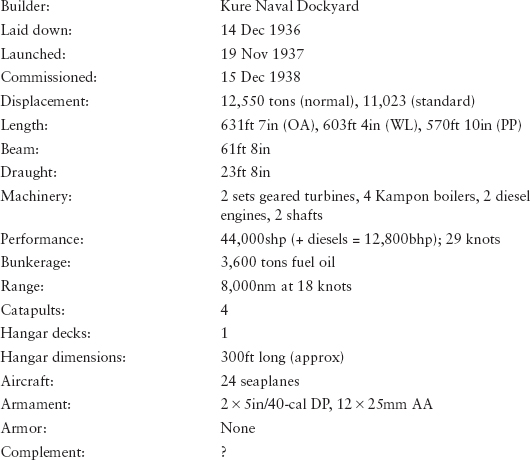
NOTES: These ingenious multipurpose vessels were designed as seaplane carriers that could be converted to fast oilers, submarine tenders, or light aircraft carriers at need. They could also operate midget submarines from the hangar deck via a ramp and gate mechanism in the stern. Both were converted to light carriers in 1942–43.
Fig. A4-12. Seaplane carrier Chitose
Fig. A4-13. Seaplane carrier Mizuho
Builder: |
Kawasaki, Kobe |
Laid down: |
1 May 1937 |
Launched: |
16 May 1938 |
Commissioned: |
25 Feb 1939 |
Displacement: |
12,150 tons (normal), 10,929 (standard) |
Length: |
631ft 6in (OA), 602ft 6in (WL), 570ft 10in (PP) |
Beam: |
61ft 8in |
Draught: |
23ft 3in |
Machinery: |
2 × 4-cycle diesels, 2 shafts |
Performance: |
15,200bhp; 22 knots |
Bunkerage: |
3,600 tons fuel oil |
Range: |
8,000nm at 16 knots |
Catapults: |
4 |
Hangar decks: |
1 |
Hangar dimensions: |
300ft long (approx) |
Aircraft: |
24 seaplanes |
Armament: |
6 × 5in/40-cal DP, 12 × 25mm AA |
Armor: |
None |
Complement: |
? |
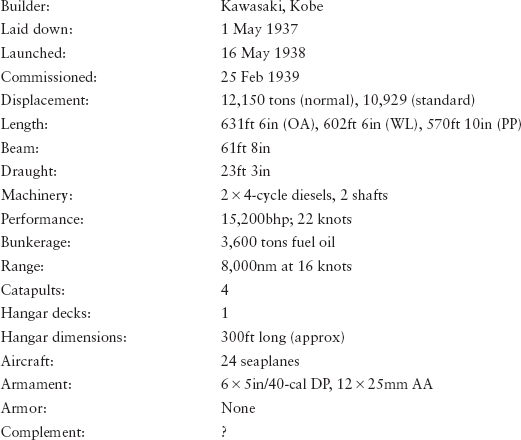
NOTES: A less successful variant of the earlier Chitose class, the Mizuho was hampered by a diesel propulsion system that delivered 5 knots less speed than her planned 27 knots. She was sunk by an American submarine near Japan in May 1942.